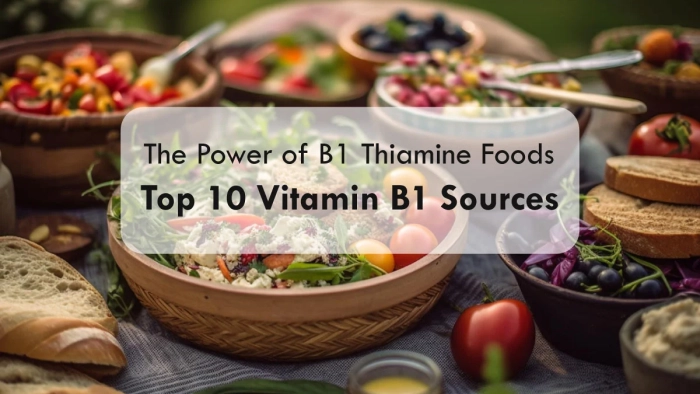Thiamin, also known as Vitamin B1 or thiamine, plays a vital role in maintaining cellular function, promoting brain health, and supporting metabolism, which in turn affects various organ functions (1). Though thiamin deficiency is rare, its consequences can be severe, leading to the degeneration of the nervous and circulatory systems (2,3). Incorporating B1 thiamine foods into your diet is essential for maintaining proper thiamin levels.
A lack of thiamin can result in conditions like beriberi and Wernicke-Korsakoff syndrome, both characterized by symptoms such as extreme fatigue and degeneration of the cardiovascular, nervous, muscular, and gastrointestinal systems (2). It’s worth noting that these symptoms are more prevalent in regions where non-enriched white rice and refined grains are the dietary staples (3).

Interestingly, there is no evidence of over-consumption of thiamin, and one study even suggests that significantly exceeding the daily recommended value (DV) may enhance brain functioning (4). Additionally, maintaining adequate thiamin levels may contribute to the prevention of conditions like Alzheimer’s disease (5,6).
Incorporating B1 Thiamine Foods into your diet is a simple and effective way to ensure you’re getting enough of this essential nutrient. The current DV for Vitamin B1 is 1.2mg (7).
Below, you’ll find a list of the top 10 foods highest in thiamin, ranked by common serving sizes. These B1 Thiamine Foods not only provide an excellent source of thiamin but also offer a variety of other nutritional benefits.
Table of Contents
- List of High B1 Thiamine Foods
- Thiamin (B1) Requirements by Age and Gender
- About the Data
- About Nutrient Targets
- Data Sources and References
List of High B1 Thiamine Foods
1. Lean Pork Chops
| Thiamin in a 6oz Chop | Thiamin per 100g | Thiamin per 200 Calories |
| 1.1mg (96% DV) | 0.7mg (56% DV) | 0.7mg (58% DV) |
- More Pork Products High in Thiamin:
- 96% DV in 1 cup of cured ham
- 69% DV in 3oz of pork tenderloin
- 66% DV in 3oz of salami
2. Fish (Salmon)
| Thiamin per 6oz Fillet | Thiamin per 100g | Thiamin per 200 Calories |
| 0.6mg (48% DV) | 0.3mg (28% DV) | 0.3mg (28% DV) |
- More Fish High in Thiamin:
- 39% DV in a 6oz tuna fillet
- 33% DV in a 3oz trout fillet
- 27% DV in a 5oz catfish fillet
3. Flax Seeds
| Thiamin per Oz | Thiamin per 100g | Thiamin per 200 Calories |
| 0.5mg (39% DV) | 1.6mg (137% DV) | 0.6mg (51% DV) |
- More Nuts and Seeds High in Thiamin:
- 35% DV in 1oz of sunflower seeds
- 28% DV in 1oz of macadamia nuts
- 21% DV in 1oz of pistachios
4. Navy Beans
| Thiamin per Cup | Thiamin per 100g | Thiamin per 200 Calories |
| 0.4mg (36% DV) | 0.2mg (20% DV) | 0.3mg (28% DV) |
- More Beans High in Thiamin:
- 35% DV in 1 cup of black beans
- 29% DV in 1 cup of black-eyed peas
- 28% DV in 1 cup of lentils
5. Green Peas
| Thiamin per Cup Cooked | Thiamin per 100g | Thiamin per 200 Calories |
| 0.4mg (35% DV) | 0.3mg (22% DV) | 0.6mg (51% DV) |
6. Firm Tofu
| Thiamin per Cup | Thiamin per 100g | Thiamin per 200 Calories |
| 0.4mg (33% DV) | 0.2mg (13% DV) | 0.2mg (18% DV) |
- More Soy Foods High in Thiamin:
- 39% DV in 1 cup of cooked green soybeans
- 62% DV in a 16oz glass of soymilk
- 11% DV in 1 cup of tempeh
7. Brown Rice
| Thiamin per Cup | Thiamin per 100g | Thiamin per 200 Calories |
| 0.4mg (30% DV) | 0.2mg (15% DV) | 0.3mg (24% DV) |
- More Whole Grains High in Thiamin:
- 21% DV in 2 slices of whole wheat bread
- 20% DV in 1 cup of cooked cornmeal (grits)
- 17% DV in 1 cup of quinoa
- 15% DV in 1 cup of oatmeal
8. Acorn Squash
| Thiamin per Cup Cooked | Thiamin per 100g | Thiamin per 200 Calories |
| 0.3mg (29% DV) | 0.2mg (14% DV) | 0.6mg (50% DV) |
9. Asparagus
| Thiamin per Cup Cooked | Thiamin per 100g | Thiamin per 200 Calories |
| 0.3mg (24% DV) | 0.2mg (14% DV) | 1.5mg (123% DV) |
10. Mussels
| Thiamin per 3oz | Thiamin per 100g | Thiamin per 200 Calories |
| 0.3mg (21% DV) | 0.3mg (25% DV) | 0.3mg (29% DV) |
- More Seafood High in Thiamin:
- 24% DV in 20 small clams
- 16% DV in 3oz of abalone (sea snails)
- 9% DV in 3oz of oysters
Thiamin (B1) Requirements by Age and Gender
The recommended daily allowance (RDA) for thiamin (Vitamin B1) varies depending on age and gender, ranging from 0.2mg to 1.4mg per day. The daily value for vitamin B1 is 1.2mg per day (7).
- Infants
- 0-6 months old: 0.2mg
- 7-12 months old: 0.3mg
- Children
- 1-3 years old: 0.5mg
- 4-8 years old: 0.6mg
- Males
- 9-13 years old: 0.9mg
- 14-18 years old: 1.2mg
- 19-50 years old: 1.2mg
- 50+ years old: 1.2mg
- Females
- 9-13 years old: 0.9mg
- 14-18 years old: 1mg
- 19-50 years old: 1.1mg
- 50+ years old: 1.1mg
- Pregnancy
- 14-18 years old: 1.4mg
- 18+ years old: 1.4mg
- Lactation
- 14-18 years old: 1.2mg
- 18+ years old: 1.2mg
The amounts for children less than 12 months old represent the adequate intake (AI) rather than RDA.
Source: Dietary Reference Intakes for Thiamin.
About the Data
Data for the curated food lists comes from the USDA Food Data Central Repository. You can check our data against the USDA by clicking the (Source) link at the bottom of each food listing. Note: When checking data, please ensure the serving sizes are the same. If you find any discrepancies, please contact us, and we will rectify them promptly.
About Nutrient Targets
Setting nutrient targets can provide a helpful guide for healthy eating. Some popular targets include:
- Daily Value (%DV): A general guideline to prevent nutrient deficiency in most people, accounting for absorption factors. It’s set by the U.S. FDA.
- Recommended Dietary Allowance (%RDA): Sets an average daily dietary intake sufficient to meet the nutrient requirements of nearly all healthy individuals. It varies by age and gender and is set by the US National Instutites of Health.
- Reference Dietary Intake (%RDI): Similar to RDA but specific to age and gender, and used for amino acids. The RDI for amino acids is set by the U.N. World Health Organization.
- Adequate Intake (%AI): Primarily used for omega-3 and omega-6 fats. The AI is set by the U.S. Institute of Medicine and reflects that the ideal intake for these nutrients hasn’t been scientifically determined yet.
Data Sources and References
- The importance of thiamine (vitamin B1) in humans
- Shible AA, Ramadurai D, Gergen D, Reynolds PM. Vitamin B1 (Thiamine) Deficiency Am J Case Rep. 2019 Mar 13;20:330-334. doi: 10.12659/AJCR.914051. 30862772
- Shible AA, Ramadurai D, Gergen D, Reynolds PM. Thiamine deficiency disorders: a clinical perspective Am J Case Rep. 2019 Mar 13;20:330-334. doi: 10.12659/AJCR.914051. 30862772
- Benton D, Fordy J, Haller J. Thiamine supplementation mood and cognitive functioning Psychopharmacology (Berl). 1995 Feb;117(3):298-305. doi: 10.1007/BF02246104. 7770605
- Chen Z, Zhong C. Supplemental thiamine as a practical, potential way to prevent Alzheimer’s disease from commencing Prog Neurobiol. 2013 Sep;108:21-43. doi: 10.1016/j.pneurobio.2013.06.004. Epub 2013 Jul 11. 23850509
- Vignisse J, Sambon M, Gorlova A, Pavlov D, Caron N, Malgrange B, Shevtsova E, Svistunov A, Anthony DC, Markova N, Bazhenova N, Coumans B, Lakaye B, Wins P, Strekalova T, Bettendorff L. Neuroprotective Effects of Thiamine and Precursors with Higher Bioavailability: Focus on Benfotiamine and Dibenzoylthiamine Mol Cell Neurosci. 2017 Jul;82:126-136. doi: 10.1016/j.mcn.2017.05.005. Epub 2017 May 12. 28506637
- U.S.FDA – Daily Value on the New Nutrition and Supplement Facts Labels
- Office of Dietary Supplements on Thiamin


